List of Japanese flags
This is a list of Japanese flags, past and present. Historically, each daimyō had his own flag. (See sashimono and uma-jirushi.)
| Wikimedia Commons has media related to Flags of Japan. |
National flags
| Flag | Date | Use | Description |
|---|---|---|---|
 | August 13, 1999 – present | Civil and state flag and ensign of Japan. | Flag ratio: 2:3. This flag was designed by Proclamation No. 127, 1999. The sun-disc is perfectly centered and is a brighter shade of red. |
.svg.png) | February 27, 1870 – August 12, 1999 | Civil and state flag and ensign of the Empire of Japan, and the Japanese state. | Flag ratio: 7:10. Disc is shifted 1% towards the hoist (left). This flag was designed by Proclamation No. 57, 1870. |
Imperial flags
| Flag | Date | Use | Description |
|---|---|---|---|
 | 1868–present | Imperial Standard of the Emperor of Japan | 16 petal chrysanthemum, colored in gold, centered on a red background |
 | 1926–present | Imperial Standard of the Regent of Japan | Similar to the Emperor's standard, but with a white border |
gou_Flag.svg.png) | 1926–present | Imperial Standard of the Empress, the Empress Dowager, and the Grand Empress Dowager | A pennant of the Imperial Standard |
_Flag.svg.png) | 1926–present | Imperial Standard of the Crown Prince and the Imperial Grandson who is an heir apparent | Similar to the Emperor's standard, but with a white orle |
hi_Flag.svg.png) | 1926–present | Imperial Standard of the Crown Princess and the wife of the Imperial Grandson | A pennant of the Standard of the Crown Prince |
 | 1926–present | Imperial Standard of other members of the Imperial House | A gold 16-petaled chrysanthemum centered on a white background with a red border |
Governmental flags
| Flag | Date | Use | Description |
|---|---|---|---|
 | 1872–1887 | Ensign of Japan Post | Hinomaru with a red horizontal bar placed in the center of the flag. |
 | 1892–present | Ensign of Japan Customs | White represents land, blue represents sea, and the red disc represents the customs on a border. |
Military flags
Self-Defense Force and Imperial Army/Navy
| Flag | Date | Use | Description |
|---|---|---|---|
 | 1954–present | Flag of the Japan Self-Defense Forces and the Japan Ground Self-Defense Force | A sun disc design with 8 red rays extending outward, and a gold border partially around the edge. |
 | 1889–1945 | Ensign of the Imperial Japanese Navy | Sun disc with 16 rays on a white field, with the disc skewed to the hoist |
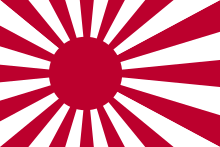 | 1954–present | Ensign of the Japan Maritime Self-Defense Force | Sun disc with 16 rays on a white field, with the disc skewed to the hoist |
.png) | 1955–1957 | Former ensign of the Japan Air Self-Defense Force | Used from 1955 to 1957. |
.svg.png) | 1957–1972 | Former ensign of the Japan Air Self-Defense Force | Used from 1957 to 1972. |
.svg.png) | 1972–2001 | Former ensign of the Japan Air Self-Defense Force | Used from 1972 to 2001. |
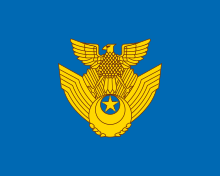 | 2001–present | Ensign of the Japan Air Self-Defense Force | Current ensign, used since 2001. |
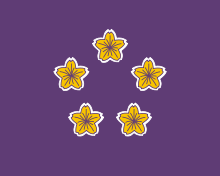 | 1972–present | Standard of the Prime Minister of Japan | Five cherry blossoms on a purple background |
 | 1972–present | Naval standard of the Prime Minister of Japan | Five cherry blossoms on a purple background |
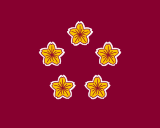 | 1972–present | Standard of the Minister of Defense of Japan | Five cherry blossoms on a magenta background |
 | 1972–present | Naval standard of the Minister of Defense of Japan | Five cherry blossoms on a magenta background |
 | 1972–present | Standard of the Vice Minister of Defense of Japan | Four cherry blossoms on a magenta background |
 | 1972–present | Naval standard of the Vice Minister of Defense of Japan | Four cherry blossoms on a magenta background |
.svg.png) | Standard of Chief of Staff, Joint Staff | ||
.svg.png) | Standard of Chief of Staff of the Japan Ground Self-Defense Force | ||
 | Standard of Chief of Staff of the Japan Maritime Self-Defense Force | ||
.svg.png) | 1982– | Standard of Chief of Staff of the Japan Air Self-Defense Force | |
.svg.png) | 1965– | Standard of vice admiral of the Japan Maritime Self-Defense Force | |
.svg.png) | 1965– | Standard of rear admiral of the Japan Maritime Self-Defense Force | |
.svg.png) | 1965– | Standard of commodore of the Japan Maritime Self-Defense Force | |
_(JMSDF).svg.png) _(JMSDF).svg.png) | 1965– | Standards of commander of the Japan Maritime Self-Defense Force | |
.svg.png) | 1965– | Standard of senior captain of the Japan Maritime Self-Defense Force | |
| 1954– | Masthead pennant of the Japan Maritime Self-Defense Force | ||
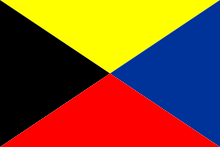 | 1905–1945, 2011– | The "Z flag", unofficial naval ensign | Derived from International maritime signal flag "Z" Made famous by its use to signal the opening of the Battle of Tsushima |
.svg.png) | Flag of composite forces chief of staff of the Japan Ground Self-Defense Force | ||
.svg.png) | 1972– | Flag of infantry battalion group of the Japan Ground Self-Defense Force | |
.svg.png) | 1982– | Flag of air defense command of the Japan Air Self-Defense Force | |
.svg.png) | 1870–1945 | War flag of the Imperial Japanese Army | Centered sun disc with 16 rays on a white field |
 | 1889–1945 | Standard of admiral of the Imperial Japanese Navy | |
 | 1914–1945 | Standard of vice admiral of the Imperial Japanese Navy | |
 | 1914–1945 | Standard of rear admiral of the Imperial Japanese Navy | |
 | 1914–1945 | Standard of commodore of the Imperial Japanese Navy | |
 | –1945 | Standard of commander of the Imperial Japanese Navy | |
 | –1945 | Standard of senior captain of the Imperial Japanese Navy | |
.svg.png) | –1945 | Standard of duty ship of the Imperial Japanese Navy |
Japan Coast Guard
| Flag | Date | Use | Description |
|---|---|---|---|
 | 1951– | Ensign of the Japan Coast Guard | The symbol represents a mariner's compass. |
-bordered.svg.png) | 1951– | Standard of the Minister of Land, Infrastructure, Transport and Tourism | |
 | 1951– | Standard of the Japan Coast Guard Commandant | |
-bordered.svg.png) | 1951– | Standard of the Commander of Regional Coast Guard Headquarters | |
-bordered.svg.png) | 1951– | Flag of Commander |
Historical flags
| Flag | Date | Use | Description |
|---|---|---|---|
 | 19th century | Naval ensign of the Tokugawa Shogunate[1] | A bicolour flag consisting of three bands; white, black, and white. |
.svg.png) | 1905–1910 | Flag of the Resident General of Korea | A blue ensign with the Flag of Japan in the canton |
 | 1945–1952 | Civil and naval ensign during the occupation of Japan | Derived from International maritime signal flag "E" |
 | 1950 (Jan–Mar) | Proposed flag of Okinawa | Called the Okinawan Flag (沖縄旗) or the Ryukyu Flag (琉球旗), proposed by the Okinawa Civil Government. The US administration stated they would decide the flag after the foundation of the unified government of the islands. However, the flag was forgotten ever since. Red, white, and blue represent peace, freedom, and enthusiasm, respectively. A star represents hope. |
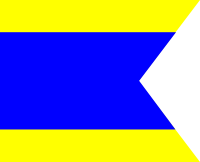 | 1952–1967 | Civil ensign during the occupation of Okinawa | Derived from International maritime signal flag "D" |
.svg.png) | 1967–1972 | Civil ensign of the Government of the Ryukyu Islands | Ryukyus pennant above Japanese flag was used during U.S. occupation of Ryukyu Islands. |
Minorities
| Flag | Date | Use | Description |
|---|---|---|---|
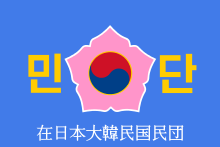 | (1996) 1994– | Flag of Mindan | Flag of Mindan, a pro-South organization of Zainichi Koreans. The pink flower surrounding the taegeuk is a hibiscus syriacus, the national flower of South Korea. The formal name of the society (Zainihon Daikanminkoku Mindan) is written in kanji in white, and the abbreviation (Mindan) is written in hangul in yellow. The blue field of the flag stands for clear sky and sea. |
 | 1923–1945 | Flag of National Levelers Association / Buraku Liberation League | Flag of National Levelers Association, a burakumin rights group, and Buraku Liberation League, NLA's succeeding group. Named the Crown of Thorns Flag (荊冠旗, Keikanki). Black represents a dark society with discriminations. Red represents blood. |
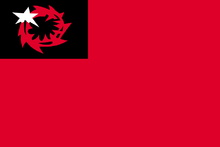 | 1945– | Flag of Buraku Liberation League | The current Buraku Liberation League flag, with a white star representing hope. |
Cultural flags
| Flag | Date | Use | Description |
|---|---|---|---|
 | 1919– | Flag of safety | Named the Green Cross (緑十字, Midori-jūji). Designed by Toshifumi Gamō as the symbol of the governmental "safety week" campaign. The cross represents philanthropism in Western sense, and the place where good deeds gather in Oriental sense. JIS Z9103-1986 designates the symbol as the safety indication sign. |
 | 1953– | Flag of industrial health | Announced by the Labour Standards Bureau, the Ministry of Labor of Japan (the current Ministry of Health, Labour and Welfare), over a public subscription. |
 | 1965– | Flag of safety and health | Designed by the Japan Industrial Safety & Health Association. These three flags are frequently flown on factories or construction sites. |
 | 1886– | Postal flag | The Postal symbol, 〒, on a white field. |
Prefectural flags
Each modern prefecture has a unique flag, most often a bicolour geometric highly stylised design (mon), often incorporating the letters of Japanese writing system and resembling company logos. A distinct feature of these flags is that they use a palette of colours not usually found in flags, including orange, purple, aquamarine and brown.
Some prefectures also have alternative official flags called "symbol flags" (シンボル旗). They may be used on less formal occasions. Famous symbol flags include the one used in Tokyo.
| Flag | Prefecture | Geocode | Description |
|---|---|---|---|
 | Aichi | JP-23 | Stylised hiragana of あいち (Aichi). The emblem also expresses sunrise and wave to indicate Aichi's location facing the Pacific Ocean. |
 | Akita | JP-05 | Stylised katakana of ア (a), the first syllable of "Akita". |
 | Aomori | JP-02 | Stylised map of the prefecture. |
 | Chiba | JP-12 | Stylised katakana of チバ (Chiba). Blue stands for hope and progress, yellow for prefecture flower, rapeseed. |
 | Ehime | JP-38 | Yellow stands for happiness, green for peace and white for simplicity and purity. The mon represents orange blossom, the prefectural flower. |
 | Fukui | JP-18 | Stylised katakana of フクイ (Fukui). The emblem stands for harmony and cooperation of people. |
 | Fukuoka | JP-40 | Stylised hiragana of ふく (fuku). It also represents ume (plum), the prefectural flower. |
 | Fukushima | JP-07 | Stylised hiragana of ふ (fu). |
 | Gifu | JP-21 | Stylised kanji 岐 (gi). The emblem expresses peace and harmony. The green stands for the nature of Gifu. |
 | Gunma | JP-10 | Stylised kanji 群 (gun) and three crescents which stand for three mountains Mount Akagi, Mount Haruna and Mount Myōgi. Purple was selected as refined colour suitable to Gunma's cultural inheritance. |
 | Hiroshima | JP-34 | Stylized katakana of ヒ (hi). |
 | Hokkaidō | JP-01 | A seven-pointed star standing for hope and development. Blue represents sea and sky of Hokkaidō, red stands for people's energy and white for light and snow. |
 | Hyōgo | JP-28 | Stylized kanji of 兵 (hyō). It also represents the stylised map of the prefecture, facing the Seto Inland Sea and the Sea of Japan. |
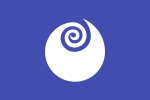 | Ibaraki | JP-08 | The prefectural flower rose on blue field. Blue stands for the Pacific Ocean and Mount Tsukuba. |
 | Ishikawa | JP-17 | The mon is a stylised form of its name in kanji, 石川 (Ishikawa). It also represents the stylised map of the prefecture. |
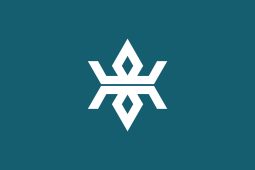 | Iwate | JP-03 | Stylised kanji of 岩 (iwa) which symbolises advanced progress. |
 | Kagawa | JP-37 | Stylised and slightly rotated katakana of カ (ka). It also represents mountains, as well as leaves of the olive, the prefectural tree. |
 | Kagoshima | JP-46 | Stylised map of the prefecture, with Sakurajima in the center. |
 | Karafuto | N/A | Stylised kanji of 太 (futo) in the form of three birch 樺 (kaba) leaves and fruit, making the rebus of 樺太 (Karafuto). Used from 1911–1945; the territory is now part of Russia. |
 | Kanagawa | JP-14 | Stylised kanji of 神 (ka). The Japanese national colours were chosen due to the Yokohama seaport, long used as a primary gateway into Japan, being located within the prefecture. |
 | Kōchi | JP-39 | Stylised hiragana of とさ (Tosa), the name of the former province. The mon also incorporates 90 degrees rotated katakana of コ (ko). |
 | Kumamoto | JP-43 | Stylised katakana of ク (ku). It also represents the stylised map of Kyūshū. |
 | Kyoto | JP-26 | Stylized kanji of 京 (kyō). |
 | Mie | JP-24 | Stylized hiragana of み (mi). The circle also represents pearls aquafarmed in the prefecture. |
 | Miyagi | JP-04 | Stylised hiragana of み (mi). It also represents the miyaginohagi (lespedeza), the prefectural flower. |
 | Miyazaki | JP-45 | Stylized katakana of ミ (mi). |
 | Nagano | JP-20 | Orange flag with white mon closer to the hoist. The mon is a stylized katakana of ナ (na). It also represents mountains mirrored on a lake. |
 | Nagasaki | JP-42 | Stylised form of the letter N. It also represents a dove, the symbol of peace. There are two versions, one with the prefectural name in kanji, another without it. Both are official. |
 | Nara | JP-29 | Stylised katakana of ナ (na). |
 | Niigata | JP-15 | The symbol on the top is a stylised kanji 新 (nii) of Niigata, while the left half of the circle is a stylised katakana for ガ (ga) and the right, タ (ta). |
 .png) | Ōita | JP-44 | Three stylised kanji of 大 (ō). Each kanji also represents a flying bird, and the whole symbol represents the sun. There are two versions, one with the prefectural name in kanji, another without it. Both are official. |
 | Okayama | JP-33 | Stylized kanji of 岡 (oka). The simplified version uses the white symbol instead of gold. |
 | Okinawa | JP-47 | White letter O within a red disc on a white field. |
 | Ōsaka | JP-27 | The blue stands for cleanness, freshness and intelligence and also represents the sky and sea due to Ōsaka City having both an airport and seaport. The blue also represents Ōsaka's nickname water city, due to having many rivers and facing two seas. The mon represents calabash, the symbol of Toyotomi Hideyoshi. Circles also describe the letter O. |
 | Saga | JP-41 | The mon is Japanese cinnamon, the prefectural flower. |
 | Saitama | JP-11 | Sixteen magatama (ornamental beads) representing the sun as well as development and strength. Magatama were found in Sakitama Kofun (ancient tombs), Gyōda, which is the origin of the name of the prefecture. White stands for purity and friendship. |
 | Shiga | JP-25 | Stylised katakana of シガ (Shiga). The circle in the centre represents Lake Biwa. |
 | Shimane | JP-32 | Four stylised katakana of マ (ma). In Japanese, "four" is shi. |
 | Shizuoka | JP-22 | Stylised map of the prefecture and Mount Fuji. Blue stands for the sky and the Pacific Ocean and orange for sun light, passion and unity of people. |
 | Tochigi | JP-09 | Stylised kanji of 栃 (tochi) and kanji 木 (gi) with three arrows. The flag represents improvement and active motion. |
 | Tokushima | JP-36 | Stylised hiragana of とく (toku). It also represents a flying bird. |
 | Tokyo | JP-13 | The sun represents the developing capital city Tokyo. This is the official "metropolitan flag", used on formal occasions. See Insignias of Tokyo for details. |
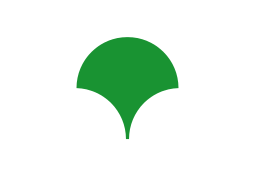 | The symbol at the centre consists of three arcs combined to resemble a ginkgo leaf and represent T for Tokyo.[2] This is the official "symbol flag", used more frequently than the flag (crest) above. See Insignias of Tokyo for details. The symbol is also for the Toei Subway logo. | ||
 | Tottori | JP-31 | The symbol is meant to represent the hiragana と (to) and a bird (tori) to form a rebus of Tottori. |
 | Toyama | JP-16 | The symbol is meant to represent the hiragana と (to) and two mountains (yama) to form a rebus of Toyama. It also represents Mount Tateyama. |
 | Wakayama | JP-30 | Stylised katakana of ワ (wa). |
 | Yamagata | JP-06 | Three mountains (yama). The form also represents the stream of the Mogami River running through Yamagata. Blue stands for desire for peace and ideal, white for snow and purity of people. |
 | Yamaguchi | JP-35 | Stylised kanji of 山口 (Yamaguchi). The emblem represents a bird flying towards the sun and stands for cooperation and progress of people. |
 | Yamanashi | JP-19 | Stylised kanji of 山 (yama) in the centre of Mount Fuji. Purple represents the grape, a popular product of Yamanashi. |
Municipal flags
Most municipalities have unique flags. Like prefectural flags, most of them are with a bicolour geometric highly stylized symbol, often incorporating Japanese characters.
References
- http://www.fotw.info/flags/jp_daimy.html#tok
- "Archived copy". Archived from the original on 2013-02-10. Retrieved 2013-02-18.CS1 maint: archived copy as title (link)